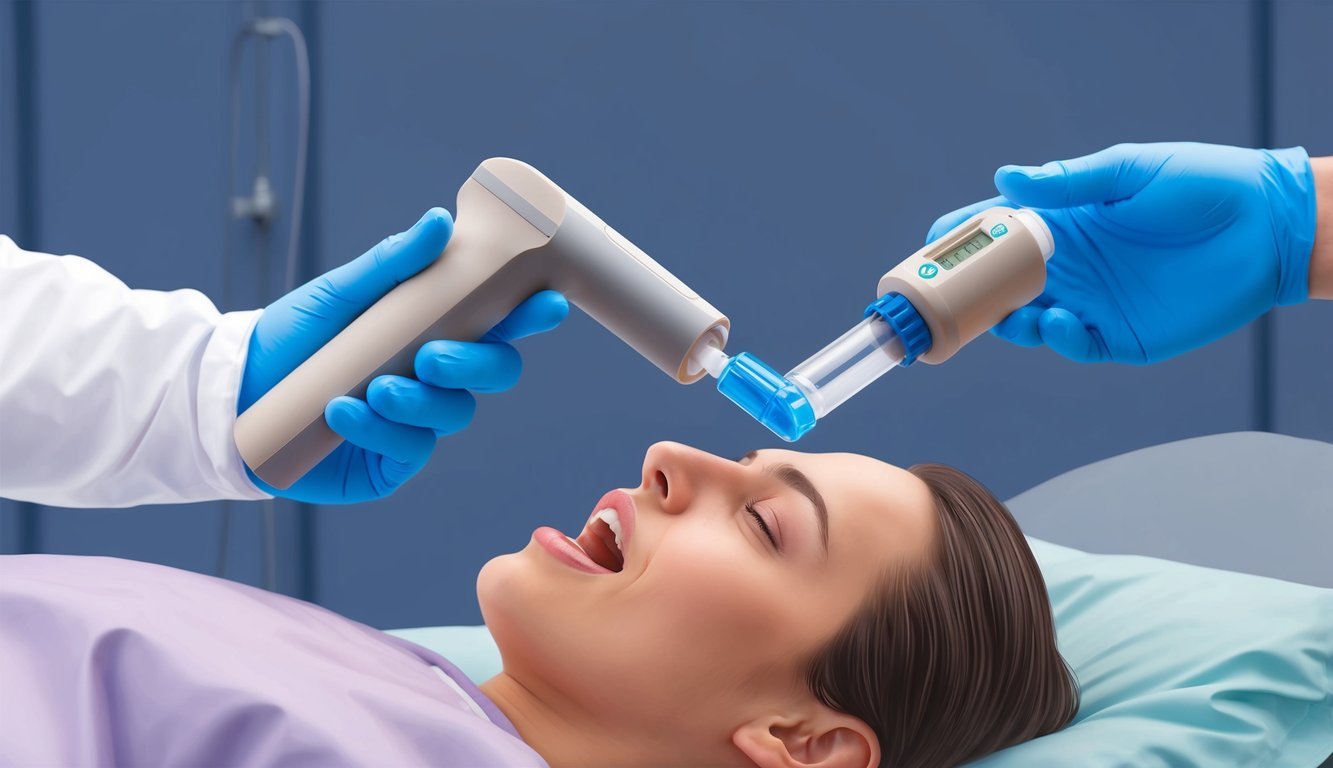Nurse practitioners (NPs) play an essential role in patient care, often stepping into responsibilities traditionally held by doctors.
Some nurse practitioners can intubate, depending on their training and state regulations.
This capability is vital in emergency situations and for patients needing critical care.
Understanding the scope of practice for NPs is crucial as it can vary widely, impacting their ability to perform procedures like intubation.
As healthcare continues to evolve, so does the role of nurse practitioners in various settings.
NPs receive specialized training that may enable them to manage airways effectively, especially in acute care environments.
This makes their skills invaluable in ensuring patient safety and timely interventions.
With a growing demand for healthcare services, the career outlook for NPs continues to improve.
Knowing the possibilities and limitations of NPs in procedures like intubation can help patients, healthcare providers, and policymakers make informed decisions about care.
Key Takeaways
- Some nurse practitioners are qualified to perform intubations based on their training and state laws.
- NPs are increasingly integral to patient care in various healthcare settings.
- The scope of practice for nurses continues to expand, enhancing career opportunities.
Scope of Practice for Nurse Practitioners
The scope of practice for nurse practitioners (NPs) is defined by legal and regulatory frameworks that vary significantly across different states.
This section explores how these frameworks impact the ability of NPs to perform specific procedures, including intubation, within their practice.
Understanding Legal and Regulatory Frameworks
Nurse practitioners operate under guidelines set by their respective state nursing practice acts.
These laws outline what activities NPs can perform based on their training and education.
You must familiarize yourself with your state’s regulations, as they dictate your ability to perform advanced procedures.
Key Points to Consider:
- Licensing Requirements: NPs need to hold a valid state license.
- Educational Background: Advanced practice registered nurses must complete specific training in areas like intubation.
- Collaborative Agreements: Some states require NPs to have oversight or collaboration agreements with physicians.
It’s essential to understand these frameworks to ensure compliance and safe practice.
Variations in State Regulations for Intubation
Intubation is a complex procedure, and regulations differ from state to state regarding who can perform it.
In some states, trained NPs may intubate patients in emergency situations, while in others, this task might be restricted to physicians.
Consider these examples:
| State | Intubation Authority |
|---|---|
| Arizona | NPs with ACLS training can intubate. |
| Texas | Intubation not permitted without physician oversight. |
| New York | NPs can perform intubation under specific conditions. |
Before performing intubation, check your state’s nursing practice act and any regulations from nursing boards.
This knowledge is vital for both legal compliance and patient safety.
For more details, you can refer to guidelines on nurse practitioner practice authority by state.
Educational and Certification Requirements

Understanding the educational and certification requirements is vital for nurse practitioners (NPs) who want to perform intubation.
These requirements ensure that you have the necessary skills and knowledge for airway management in critical situations.
Essential Nursing Degrees and Certifications
To become a nurse practitioner eligible for intubation, you must start with a foundational nursing degree.
Typically, this means obtaining a Bachelor of Science in Nursing (BSN) or an Associate Degree in Nursing (ADN).
Following this, you need to pass the National Council Licensure Examination (NCLEX-RN) to become a registered nurse (RN).
Once you have your RN license, pursuing an advanced degree, such as a Master of Science in Nursing (MSN) or a Doctor of Nursing Practice (DNP), is necessary.
These advanced programs often include specialized training in critical care.
NPs must also earn certification from a recognized body, such as the American Nurses Credentialing Center (ANCC) or the American Association of Nurse Practitioners (AANP).
Specialized Training in Airway Management
Nurse practitioners can enhance their skills in airway management through specialized training.
This often includes Advanced Cardiac Life Support (ACLS) training.
Many facilities and programs offer ACLS classes that teach NPs how to manage respiratory emergencies effectively.
You may also consider enrolling in intubation training programs specifically designed for NPs.
Such programs cover essential techniques, patient assessment, and practice scenarios.
Some institutions even provide online nursing degree options that incorporate these specialized skills.
Attending workshops or certifications in airway management can further prepare you for the responsibilities of intubation.
Training in both theory and practical skills is crucial to ensure safety in high-pressure situations.
Clinical Competencies in Intubation Procedures
Understanding the critical competencies required for intubation is essential for healthcare providers in acute and critical care settings.
Mastery of airway management and intubation techniques ensures effective patient outcomes, particularly in cases of respiratory distress.
Airway Management and Intubation Techniques
Successful intubation relies on proper airway management techniques.
You need to assess the airway quickly to determine the best approach.
Key techniques include:
- Direct Laryngoscopy: This method uses a laryngoscope to visualize the vocal cords for tube placement.
- Video Laryngoscopy: This approach provides a better view of the airway, especially in difficult cases.
You need to be familiar with various endotracheal tube sizes and the conditions that indicate their use.
Factors include the patient’s age, size, and clinical condition.
Proper training and practice on intubation manikins help build the skills necessary to perform these procedures effectively.
Integration of Acute Care and Critical Care Skills
As an Acute Care Nurse Practitioner (ACNP), your role may include intubation in emergencies.
You need to integrate critical care skills effectively.
Understanding the underlying reasons for respiratory distress is vital, whether from trauma, infection, or other causes.
Practitioners must stay current on protocols for managing complex cases.
This includes knowledge of sedatives, paralytics, and the impact of intubation on the patient’s physiological state.
Collaboration with the healthcare team can enhance skill competency, ensuring that you provide the best care possible.
For further insights, explore guidelines on endotracheal intubation.
Roles of Nurse Practitioners in Various Healthcare Settings

Nurse practitioners (NPs) play vital roles in different healthcare environments.
They work in emergency situations, specialized care, and critical care units, making significant contributions to patient outcomes and care efficiency.
Emergency Response and Hospital Departments
In emergency departments, NPs are essential healthcare providers.
They assess, diagnose, and treat patients experiencing acute health issues.
Their roles can include:
- Initial Assessment: Quickly evaluating patients’ conditions.
- Stabilization: Providing emergency care for critical patients.
- Collaboration: Working closely with physicians and other healthcare staff.
In many hospital settings, NPs manage patient flow efficiently, shortening wait times and improving satisfaction.
They often handle follow-up care, ensuring patients receive necessary treatment after their initial visit.
This collaborative approach helps reduce the burden on physicians, allowing for better overall care.
Nurse Practitioners in Specialized Care Units
In specialized care units, such as intensive care units (ICUs) and pediatric acute care, NPs demonstrate their advanced skills.
They manage complex patient needs, making critical decisions regarding treatment plans.
Key responsibilities include:
- Monitoring: Keeping track of vital signs and clinical changes.
- Medication Management: Administering treatments tailored to specific conditions.
- Patient Education: Informing families about care options and procedures.
In critical care settings, NPs often lead clinical teams, ensuring integrated care for patients with severe health issues.
Their ability to provide specialty care, coupled with their advanced training, makes them invaluable in these high-stakes environments.
For more information on the roles of nurse practitioners, consider resources from AANP and other related healthcare organizations.
Professional Development and Career Outlook

Investing in your professional development is essential for advancing your career as a nurse practitioner (NP).
Understanding the various paths available for education and job opportunities can help you achieve your goals in the field.
Advancing Through Further Education and Skills
To expand your capabilities, consider pursuing additional education.
For instance, obtaining a Doctor of Nursing Practice (DNP) or becoming a Certified Nurse Practitioner (CNP) can enhance your qualifications.
Key educational pathways include:
- BSN Degree: A Bachelor of Science in Nursing is often the first step.
- Advanced Degrees: A Master’s or Doctoral degree can lead to more specialized roles.
You may also want to pursue certifications in critical care or advanced cardiac life support (ACLS).
These credentials can increase your competency in emergency situations, such as intubation.
Exploring Job Opportunities and Growth
The job outlook for NPs is very promising.
According to the U.S. Bureau of Labor Statistics, employment in this field is expected to grow by 52% from 2019 to 2029.
Factors contributing to this growth include:
- An aging population requiring more healthcare services.
- A shift towards preventative care, where NPs play a crucial role.
You can look into various specialties, such as family nurse practitioners or acute care NPs, to find roles that interest you.
Networking through professional organizations can also open doors to new opportunities.
If you are proactive about advancing your education and skills, you will significantly increase your chances of enjoying a successful career as a nurse practitioner.
Frequently Asked Questions

This section addresses key questions about nurse practitioners and their ability to perform intubation.
It covers state regulations, qualifications, and specific circumstances under which intubation can occur.
In which states are nurse practitioners permitted to perform intubation?
Nurse practitioners (NPs) can perform intubation in several states, depending on state laws and regulations.
You should check local laws for specifics.
Are nurse practitioners authorized to intubate in California?
In California, nurse practitioners can perform intubation, but it depends on their training and the supervising physician’s protocols.
You must verify your specific practice level and facility policies.
What are the qualifications required for a nurse practitioner to intubate patients?
To perform intubation, you need to have advanced training.
This may include certifications in Advanced Cardiac Life Support (ACLS) and airway management courses.
Is it within the scope of practice for nurse practitioners to intubate in New York?
In New York, NPs can intubate as part of their practice, but only if they meet specific training requirements.
Your facility policies should define any additional guidelines.
What advanced practice nurses have the ability to intubate?
Advanced practice nurses, such as Certified Registered Nurse Anesthetists (CRNAs) and some Acute Care Nurse Practitioners (ACNPs), have the training to perform intubation.
You should confirm the specifics based on your role and training.
Under what circumstances can a nurse practitioner legally perform intubation?
A nurse practitioner can legally perform intubation in emergencies.
They can also do so when designated by protocols in a clinical setting.
Always follow your facility’s guidelines and state regulations for these procedures.

